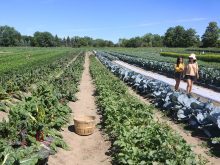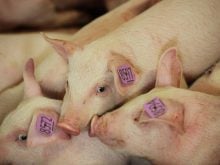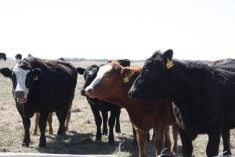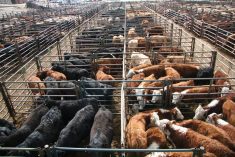CALGARY – A hay shortage is forcing British Columbia cattle pro-ducers to forage for feed.
A harsh winter followed by a cool spring has resulted in a busy year for hay brokers like Fred Payne in Kamloops. He has imported about 3,000 tonnes of hay, mostly from Alberta. That’s double his usual business.
His company has sourced hay from Calgary, Edmonton and Ponoka for the B.C. cow/calf and horse market. Ordinarily, at this time of year, cows and their calves are grazing on pasture.
Read Also

Canada told trade crisis solutions in its hands
Canadians and Canadian exporters need to accept that the old rules of trade are over, and open access to the U.S. market may also be over, says the chief financial correspondent for CTV News.
Belgium Farms at Lomond, Alta., owned by Firmin Declercq, has hauled hay to dairy farms as far as Vancouver Island, plus to the Vanderhoof and Kootenay regions in the B.C. Interior.
Carla Kallio of Belgium Farms said about 95 percent of their hay was shipped to B.C. this year. As a result they’re out of alfalfa cubes and dipping into their store of two-year-old hay.
“It’s been a busy, busy year,” she said.
B.C. district agriculturalists said because of shortages, prices are almost double, ranging from $140 to $180 a tonne for mixed alfalfa-timothy.
Klaas Boersma, of the B.C. Forage Council in Kamloops, said the area can usually meet its forage needs but last year’s dry summer also shortened yields so carryover was below normal. Winterkill in alfalfa is also being reported, which means costly reseeding.
Cranbrook agriculturist Mike Malmberg said: “We’ve had a longer feeding period this winter than we’ve experienced for a number of years. It’s also been more severe in terms of the amount of snow and low temperatures that’s driven up the demand for hay.”
Ordinarily the Creston area is a net exporter and supplies the Kootenays but this year farmers are forced to search for hay in Alberta, particularly in the southern portion of the province.
A few herds have moved out to pasture but most will be delayed because the grass isn’t growing quickly enough to support heavy grazing.
“We’re at least two weeks behind normal on a crown range grass growth,” said Malmberg.
Ted Moore of the agriculture department in Kamloops said local supplies are almost depleted and on top of that, extended cool weather stalled pasture and hay field regrowth.
Another factor in B.C. is a switch to special crops like ginseng that take land out of production for four to five years.
“In recent years there’s been a tighter (hay) supply because of increased acres of alternate crops, particularly ginseng,” Moore said. There are about 900 acres of ginseng seeded throughout the province.
In the far southern portion farmers are often cutting hay by the end of May, but this is also delayed because of unseasonably cold, wet weather.















